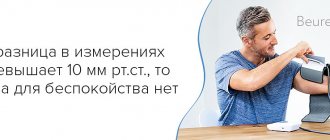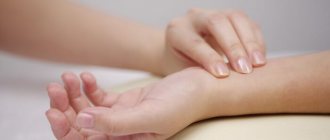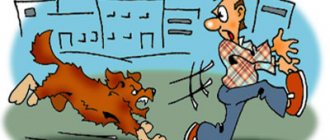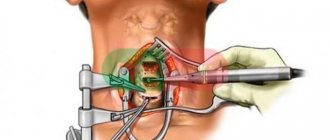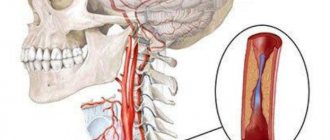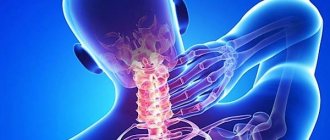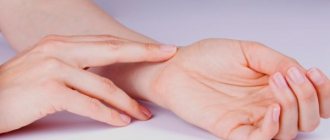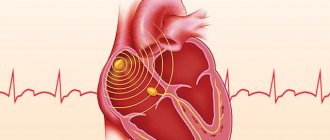Normally, the pulse is the same in both arms
If the pulse is the same in both hands, then the study of its characteristics is carried out on one hand.
The pulse in symmetrical areas may be different (p.differents). Pathological processes (unilateral anomalies in the structure and location of peripheral vessels, compression of arteries by tumors, scars, enlarged lymph nodes, aneurysm of the aorta and its branches, mediastinal tumors, retrosternal localization of goiter) can deform the arterial vessel along the path of the pulse wave.
A unilateral decrease in pulse filling appears with or without a simultaneous delay in the pulse wave.
Popov-Savelyev symptom: the pulse in the left arm is less full (especially in the position on the left side) with mitral stenosis, since the hypertrophied left atrium compresses the left subclavian artery.
After determining the sameness (uniformity) of the pulse in both hands, determine the rhythm.
The rhythm of the pulse does not depend on the condition of the arteries, but reflects the nature of the contraction of the left ventricle of the heart.
The pulse is rhythmic, regular (p.regularis) - pulse beats are felt at regular intervals.
Pulse uniform – pulse waves are equal to each other.
Impaired pulse regularity – arrhythmic pulse (p.irregularis).
Pulse waves become different in size - uneven pulse.
- respiratory arrhythmia - the pulse during breathing movements either quickens (when inhaling) or slows down (when exhaling). It is characteristic that by holding the breath this type of arrhythmia is eliminated;
- extrasystole - pulse waves, smaller in magnitude, appear earlier than usual (premature contractions), followed by a longer pause (compensatory pause);
- atrial fibrillation - arrhythmic pulse, its individual waves of different sizes;
- paroxysmal tachycardia - suddenly begins in the form of an attack and also ends suddenly, the pulse reaches a frequency of more than 140 beats per minute, which does not happen with other rhythm disturbances;
- third degree atrioventricular block - very rare (less than 40 beats per minute), regular and not changing in frequency pulse.
To determine the pulse rate, three fingers of the palpating hand (second, third, fourth) are placed on the radial artery and the number of pulse beats is counted in 15 seconds or 30 seconds and the resulting number is multiplied by 4 or 2, respectively (with a rhythmic pulse). If the pulse is arrhythmic, count for at least 1 minute.
The normal heart rate is 1 minute.
Normally, the pulse rate fluctuates significantly depending on age, gender, and height. In newborns, the pulse rate reaches 140 beats per minute. The pulse rate is often higher the higher the patient is.
In the same person, depending on the time of eating, movements, depth of breathing, mental state, body position, the pulse rate constantly changes.
Frequent pulse (p.frequens) – pulse rate more than 90 per minute.
Rare pulse (p.rarus) – pulse rate less than 60 per minute.
A rapid pulse occurs during physical and mental stress, with sinus tachycardia, heart failure, a drop in blood pressure, anemia, thyrotoxicosis, an attack of paroxysmal tachycardia, and pain. When body temperature rises by 1ºC, the pulse rate increases by 8-10 beats per minute.
A rare pulse occurs during sleep, in athletes, and with negative emotions. It is an indicator of pathology in case of blockade of the conduction system of the heart, hypothyroidism, increased intracranial pressure, and jaundice (parenchymal and mechanical).
Pulse deficiency - the number of heart contractions and the number of pulse waves in the periphery may not coincide (with atrial fibrillation).
Pulse deficiency is determined by palpation and auscultation in patients with arrhythmia.
There are two ways to determine pulse deficit.
First way. At the same time, place a stethoscope on the area of the apex of the heart to count the number of heartbeats, and palpate the pulse on the radial artery with the other hand (Fig. 5.5.2).
After counting the pulse rate for a minute, for the next minute those heartbeats that were not accompanied by the appearance of a pulse wave on the radial artery are counted - that is, a pulse deficit.
Second way. Within a minute, the number of heart contractions is counted, the second minute - the pulse rate at the radial artery (Fig. 5.5.2). Then the pulse rate is subtracted from the number of heart contractions and the result is a pulse deficit.
The presence of a pulse deficit indicates weakness of the contractile function of the heart - not all contractions of the left ventricle are accompanied by the formation of a pulse wave in the periphery.
· Condition of the vascular wall.
Determination of the state of elasticity of the vascular wall.
To determine the condition of the wall of the radial artery, three fingers of the palpating hand (second, third, fourth) are placed on it. First, the artery is compressed with the second finger until the reverse flow of blood from the vessels of the hand stops, and then the blood is squeezed out of the vessel with the fourth finger and squeezed until the passage of the pulse wave stops (Fig. 5.5.3). The third finger lies freely on the empty artery and rolls along the wall of the vessel with sliding movements.
Normally, the arterial wall is soft, elastic, and smooth.
With atherosclerotic hardening of the artery, a dense, rough, twisted tube is felt under the third finger.
Pulse filling depends on the stroke volume, the total amount of blood in the body and its distribution throughout the vascular system.
To determine the filling of the pulse, three fingers of the palpating hand (second, third, fourth) are placed on the radial artery. First, the artery is compressed with the second finger until the reverse flow of blood from the vessels of the hand stops, and then the blood is squeezed out of the vessel with the fourth finger and squeezed until the passage of the pulse wave stops.
Normal pulse is of satisfactory filling. In this case, an indentation of the soft tissues of the finger is felt without lifting it.
Full pulse (p.plenus) - vibration of the entire palpating finger is felt.
A full pulse occurs in athletes during sports competitions and during physical activity.
Empty pulse (p.inanis) - raising the wall of the vessel does not cause a sensation of indentation of the soft tissues of the palpating finger.
Pulse filling decreases with a decrease in cardiac output (left ventricular failure) and a decrease in the volume of circulating blood (blood loss).
An empty pulse occurs with hypotension, acute cardiovascular failure (collapse, cardiogenic shock), and stenosis of the aortic mouth.
Pulse voltage depends on the value of systolic blood pressure and the tone of the vascular wall.
The degree of pulse tension is judged by the force that is necessary to compress the artery until the pulsation completely stops.
To determine the pulse voltage, the second - third - fourth fingers of the palpating hand squeeze the artery until the pulsation in it stops (Fig. 5.5.5.).
Normal pulse is of satisfactory tension. The pulsation can be suppressed by applying a certain amount of force.
Hard pulse (p. durus) - preservation of the pulsation of the artery when it is strongly compressed.
A hard pulse occurs with arterial hypertension and atherosclerosis of the arteries.
Soft pulse (p. mollis) – minimal effort is required to suppress the pulse.
A soft pulse occurs with hypotension, acute bleeding, mitral stenosis, mitral valve insufficiency, and aortic stenosis.
It is very difficult to assess the pulse value by palpation, and therefore it is indirectly judged on the basis of a total assessment of the filling and tension of the pulse wave.
The pulse value is influenced by pulse pressure and arterial filling.
large pulse (p.magnus) – pulse of good filling and tension;
small pulse (p.parvus) – pulse of low filling and tension;
thread-like pulse (filiformis) - a barely palpable small and soft pulse.
A large pulse occurs with increased heart function (aortic valve insufficiency, thyrotoxicosis, fever). In these conditions, the stroke volume of blood and the frequency of pressure fluctuations in the artery increase or the tone of the arterial wall decreases.
A small pulse occurs when the stroke volume of the left ventricle decreases and the pulse pressure decreases. It can occur when there is an obstruction between the heart and peripheral arteries - aortic stenosis or aneurysm.
Thread-like pulse occurs with large blood loss, acute vascular insufficiency (collapse), acute heart failure (cardiogenic shock).
The shape of the pulse is determined by the sphygmogram and depends on the speed and rhythm of the rise and fall of the pulse wave.
Rapid pulse - jumping, rapidly increasing, may be the result of increased stroke volume of the left ventricle (aortic valve insufficiency, thyrotoxicosis, anemia, fever), pathologically rapid release of blood (patent ductus arteriosus, arteriovenous fistulas).
A slow pulse is characterized by a slow rise and fall of the pulse wave and occurs with slow filling of the arteries (aortic stenosis, mitral stenosis).
The dicrotic pulse consists of two systolic peaks: the main pulse wave is followed by a new, like a second (dicrotic) wave of lesser strength; they correspond to only one heartbeat. The second wave of the pulse is caused by the reflection of blood in the peripheral parts of the arteries and the greater, the lower the tone of the arterial wall.
The venous pulse reflects fluctuations in the volume of the veins as a result of systole and diastole of the right atrium and ventricle, when the outflow of blood from the veins into the right atrium slows down and accelerates (respectively, the swelling and collapse of the veins).
Pulsation of the world and man
Diagnosing health by pulse is the oldest method of health monitoring. The study of the relationship between pulse activity and the human condition was carried out both in the East and in the West. The very first full-fledged work on pulse diagnostics known to Western civilization is the treatise by the Alexandrian physician of the Ptolemaic dynasty Herophilus of Chalcedon “Peri sphigmon pragmateias”.
Herophilus believed that one could determine the state of health by the pulse, as well as “foresee the future.” The doctor compared different types of pulse with musical rhythms and introduced the concepts of systole and diastole. These terms, as well as the concept of “jumping pulse”, have been preserved in modern medicine. All famous physicians of antiquity, from Galen to Paracelsus, were engaged in pulse diagnostics.
Heart rate can be measured by touching the palm of your hand to the left side of your chest:
- in men - under the left nipple;
- in women - under the left breast.
Counting on the left side of the chest with an increased pulse is considered reliable.
To measure and get correct data, you need to know how to count your pulse. To do this you need:
- Strip to the waist.
- Take a lying position.
- Record the time on a stopwatch, timer or watch.
- Place the palm of your right hand on the left side of your chest.
- Count the number of heart beats in 60 seconds.
Despite the availability of the method, not everyone knows how to count the pulse on the hand correctly. Knowing how to measure the pulse by palpating the radial artery, which is located on the wrist, you can obtain objective information about the state of your health. The radial artery is released through the skin so that its pulsation is noticeable even to a non-specialist.
To understand how to measure the pulse on your hand yourself, you should find this place:
- Sit on a chair.
- Relax your left hand.
- Place your hand palm up.
- Place the 2nd, 3rd, 4th fingers of your right hand on the inside of your wrist.
- Press the radial artery and feel the pulsation.
- Using the algorithm for measuring the pulse on the radial artery, calculate the number of pulse oscillations:
- put a stopwatch in front of you;
- Count your heart rate for 1 minute.
The heart rate of a healthy person should normally be from 60 to 80 beats per minute.
Having understood how to calculate the pulse manually, you need to decide on which hand it is preferable to measure it.
You can measure it on your hands: right and left, normally the measurement result should be the same. But practice shows that more correct results are obtained on the left hand, located closer to the heart.
The algorithm of actions when measuring pulse is not complicated, but for the reliability of the results, it requires precision execution. A step-by-step execution of the algorithm will allow you to understand how to correctly measure the pulse on your hand:
- Prepare a stopwatch and place it in a position convenient for monitoring.
- Remove items of clothing, wristwatches and rings that constrict and prevent access to blood vessels, so that nothing impedes blood circulation.
- Sit comfortably, leaning back in a chair, or take a horizontal position.
- Turn the palm of your left hand up.
- It is acceptable to lightly press your hand to your chest.
- Using three fingers of your right hand: index, middle and ring, simultaneously press on the artery.
- Feel for clear pulses of blood inside the vessel.
- Start the stopwatch and count the contraction frequency for 60 seconds.
- Measure the pulse on your right hand in a similar way.
- Record the result.
Speaking about how to calculate the pulse in 10 seconds, it must be said that this technique is used by athletes during active sports.
Using a heart rate count of 10 seconds multiplied by 6 allows them to quickly measure the number of heart beats per minute and determine physical activity.
It is not recommended to use this technique in all other cases, since this calculation has a very high error - up to 18 beats per minute! This is explained by the fact that a person cannot correctly take into account the first and last heart sounds in an exact 10-second period.
More accurate data can be obtained by recording the time spent on 10 pulsations. How to calculate the pulse per minute when measuring 10 beats:
- Feel for clear vibrations of the artery walls in a convenient place.
- Start the stopwatch.
- Count the vibrations of the artery from the second beat.
- Stop counting after 10 heartbeats.
- Record the time.
The counting method is as follows: 10 beats x (60 seconds / fixed time). For example, if 4 seconds have passed in 10 beats, then the pulse at the moment will be equal to 150 beats per second = 10 x (60 / 4).
The most accurate and functional option is to determine the pulse by palpation within 1 minute. Places available for self-examination are the arteries: radial and carotid.
The method of determination on the wrist is suitable when the subject is in a calm state. After physical activity, it is convenient to measure your pulse by placing your fingers on the carotid artery. Other methods are complex in terms of finding the ripple and the reliability of the information obtained.
0 users, 1 guests, 0 hidden users
What to do if the pressure on the right and left hands is different?
If you get different data when measuring pressure on two arms, you need to analyze several factors:
- The magnitude of the differences is within 10 mmHg. is not a cause for concern. But the larger the gap, the higher the risk of pathology;
- Compliance with the norm - when the indicator on one hand corresponds to the norm or indicates increased blood pressure, and on the second it is higher - this is a less dangerous situation. The likelihood of a pathological process is greater when the pressure on one hand is normal and the pressure on the other is low;
- Right-handed-left-handed - increased pressure on the main working hand is considered normal;
- Age – the difference in pressure on the two arms is more often recorded in adolescence and old age;
- Physical activity level – differences may occur due to vigorous exercise or heavy work;
- Unusual symptoms and health complaints – their presence indicates the need for examination.
It is especially important to measure the pressure on both arms for people who do not monitor the indicator regularly and use a tonometer occasionally. But even with daily measurements, it is worth comparing the indicators from both hands once a month.
So, a simple rule: the difference in pressure on the two arms is within 10 mm Hg. – physiological norm. Approximately 50-60% of people will get exactly this result with the appropriate measurements. If the differences are more significant, you should consult a doctor.
What does your pulse tell you?
No special equipment is required to measure pulse. Meanwhile, this simple procedure will help you learn not only about possible problems with the heart, but also about your health in general.
From bronchitis to heart disease
The normal heart rate for a healthy adult is 60-80 beats per minute. A pulse less than 60 may be a sign of decreased thyroid function and a decrease in the amount of thyroid hormones (hypothyroidism). With increased thyroid function (hyperthyroidism), on the contrary, the pulse is rapid: over 100-120 beats per minute.
A pulse rate of 81-100 beats may indicate hypertension. Also, a rapid pulse is observed in bronchial asthma and chronic bronchitis, with a decrease in the level of hemoglobin in the blood. With elevated body temperature, the pulse usually increases by 10 beats with each degree - this is a normal reaction of the body.
An important indicator is not only the frequency, but also the filling of the pulse. If one beat of the pulse is strong and the next weak, or if the pulse differs in filling on the right and left hand, this may indicate a heart defect. A barely palpable pulse in both arms is sometimes a symptom of anemia or low blood pressure.
Taking into account temperament
For heart rate readings to be reliable, you need to be able to measure it correctly. First of all, you need to press the vein not with one finger, as many are used to, but with three (index, middle and ring). The pulse should be measured while sitting (in a lying position it is lower, in a standing position it is higher). The most acceptable period for pulse diagnostics is from 11 to 13 hours. At this time of day, the pulse is calmer and more stable.
To avoid distortions, do not measure your pulse immediately after eating or drinking alcohol, during an acute feeling of hunger, after hard physical work or intense mental work, after a massage, shower, bath, sex, as well as on menstrual days.
The “behavior” of the pulse is also influenced by a person’s temperament. It is believed that choleric people are characterized by a strong pulse with a frequency of 76-83 beats per minute, for sanguine people - a strong pulse with a frequency of 68-75 beats, for phlegmatic people - a weak pulse with a frequency of less than 67 beats, for melancholic people - a weak pulse with a frequency of more than 83 beats .
One common cause of increased heart rate is stress. To pacify an “agitated” heart, it is not necessary to resort to the help of calming tablets and drops. You can try inhaling essential oils of lemon, ylang-ylang or basil. Garlic also reduces heart rate: you need to crush one clove and inhale its scent for two to three minutes.
Read the latest news from “For Each Other” on social networks:
Bian-Qiao
The Eastern school of pulse diagnostics is associated with the name of the legendary Chinese physician Bian Qiao, who lived in the 6th century BC. According to legend, one day Bian Qiao was invited to the house of a mandarin whose daughter was ill. Diagnosis and treatment were complicated by the fact that the noble girl could not be touched. Bian Qiao found a way out of the situation.
He asked to tie a long cord to the patient’s arm and give him the other end. The mandarin's servants decided to play a prank on the doctor and tied a cord to the dog's paw. Bian Qiao immediately said that the vibrations he felt were not the vibrations of a person, but of an animal, moreover, sick with worms. Realizing that it was difficult to deceive the doctor, the servants tied a cord to the hand of the mandarin’s daughter, and Bian Qiao immediately made a diagnosis from the pulsation of the rope.
Arterial pulse examination
The pulse is a periodic dilation of blood vessels, synchronous with the activity of the heart, visible to the eye or felt by the fingers. The amplitude of pulsatory vasodilation (except for the aorta) is insignificant. Therefore, catching the pulsation of blood vessels with the eye is very difficult. The main method of studying the pulse is palpation.
There are arterial, capillary and venous pulses. The most important practical value for diagnosing various pathological conditions of the body is the arterial pulse.
The reason for the rhythmic expansion of the artery pressed by the finger is the rhythmic fluctuation of intra-arterial pressure. When we compress an artery with a finger, we thereby overcome the intra-arterial blood pressure, which tends to expand the vessel. If the pressure in the artery remained the same all the time, then the finger squeezing the artery would not feel any pulsation.
But since the pressure inside the artery fluctuates rhythmically, becoming either maximum or minimum, at the moment of maximum increase in pressure the finger has to overcome more resistance; Increasing intra-arterial pressure each time stretches the artery wall, expanding its lumen. These expansions are perceived by the pressing finger as a pulse.
The study of the arterial pulse makes it possible to judge the activity of the heart, the properties of the arterial wall, the height of arterial blood pressure, in some cases, damage to the heart valves and indirectly the increase in body temperature and the state of the nervous system. That is why the study of arterial pulse is one of the most important methods used in the diagnosis of various diseases and, first of all, diseases of the cardiovascular system.
The arterial pulse is examined by palpation and by recording the pulse (sphygmography).
Feeling the pulse. In order to be able to compare the properties of the arterial pulse in different people and in the same person at different times, the pulse is felt in the same artery, namely, the radial artery. This artery was chosen for this purpose due to its superficial position directly under the skin and the presence of underlying bone to which the vessel can be easily pressed.
The radial artery is palpated between the radial styloid process. bone and tendon of the internal radial muscle. With your right hand, grab the hand of the person being examined in the area of the wrist joint from the back side so that the thumb of the examiner’s hand is on the ulnar side, and the remaining fingers are on the radial side of the forearm of the person being examined.
If it is impossible to study the pulse of the radial artery (amputation, plaster cast), you can count the number of pulse beats in the carotid or temporal artery or directly from the cardiac impulse. However, other properties of the pulse, which will be discussed later, are determined in this way with difficulty or are not determined at all.
Properties of the arterial pulse. When starting a palpation study of the radial artery pulse, you should first of all make sure whether the pulse value is the same, i.e., the degree of dilation of the arterial vessels in both arms. Therefore, you should begin examining the pulse by feeling it on both hands. Normally, the pulse value in both hands is the same. If the pulse value in one arm is greater, then such a pulse is called pulsus differens.
Most often, pulsus differens is not associated with any painful condition of the body, but depends on the anatomical variant of the course and caliber of the radial artery. If on one arm the radial artery is narrower than on the other, or if the radial artery passes to the back of the hand to the place of its usual palpation, and its branch passes at this place, the pulse value on this arm will be less (the degree of expansion of the artery, the less there is blood in it, i.e.
Pulsus differens acquires diagnostic significance in cases where it is caused by pathological changes in the body. These changes can be localized either in the radial artery itself, or in other, larger arteries of the same arm, or in the chest cavity.
When the lumen of the radial artery is narrowed due to inflammatory thickening of its intima or compression of the vessel by a scar or tumor, the pulse will be less than in the other arm. The same will happen with similar pathological changes in the brachial or subclavian artery of the same side. In these cases, due to the narrowing of the lumen of the overlying artery, the amount of blood flowing into the corresponding radial artery is less than in the other arm, which is why the pulse value in this arm is also less.
If the difference between the pulse value in the left and right arms can be traced to the subclavian artery itself, then the cause of pulsus differens should be sought in the chest cavity, mainly in the aorta. An aneurysm of the aortic arch, depending on its size and location, can compress one or another of the arterial trunks located nearby; then one upper limb may receive less blood than the other.
With mitral stenosis during a period of severe cardiac muscle failure, the dilated left atrium can compress the left subclavian artery and thereby cause a decrease in blood flow to the left arm, and consequently, the appearance of pulsus differens (Popov-Savelyev symptom).
After comparing the pulse value in both arms, you should move on to studying the properties of the radial artery pulse. To do this, you can further examine the pulse on only one hand. If there is a pulsus differens, then the properties of the pulse should be studied on the hand on which its value is greater.
Properties of the arterial wall. First of all, you should familiarize yourself with the properties of the wall of the radial artery. This is important not only for diagnosing pathological changes in the artery itself, but also because the value of the properties of the arterial wall allows for a more correct interpretation of the other properties of the pulse. The index and middle fingers of the free hand compress the radial artery above the palpating fingers (i.e.
Normally, the artery wall should be soft but elastic. If it is soft, but not elastic, this indicates a decrease in the tone of the wall muscles. This is observed, for example, in febrile diseases. If it is hard and elastic, this indicates an increase in the tone of the arterial muscles, which is observed either with increased excitability of the vasomotor center or with high intra-arterial blood pressure.
If the wall of the artery is hard and not elastic (rigid), this indicates the development of connective tissue in it or its calcification, which is a sign of arterial sclerosis, especially when the vessel also has a tortuous course. With severe sclerosis of the radial artery, it is sometimes possible to feel individual hard areas with calcareous deposits in its wall (“arteriosclerotic rosary”).
However, different parts of the arterial system are affected by arteriosclerosis not simultaneously and not to the same extent; therefore, the normal properties of the wall of the radial artery do not at all exclude sclerosis of the aorta, coronary or cerebral vessels, and, conversely, sclerosis of the radial artery is possible with normal vessels in other areas.
Properties of the arterial pulse. After becoming familiar with the properties of the arterial wall, they begin to study the properties of the pulse itself. These include: pulse frequency, rhythm, speed, voltage, magnitude and dicroticity.
Pulse rate is the number of pulse beats per minute. It is equal to the number of heart contractions during the same period. In some pathological cases, the number of pulse beats is, however, less than the number of heart contractions. In this case, they talk about pulsus deficiens (pulse deficiency). This happens when individual systoles of the left ventricle are so weak that the pressure that has barely increased in it is either not enough to open the aortic valves, or blood, if it enters the aorta, is in such a small amount that the weak pulse wave manages to smooth out before reaching the radial artery .
To determine the pulse rate, count the number of pulse beats for x/4 minutes and multiply the found number by 4. If the pulse is incorrect, count it for a whole minute, since the number of pulse beats during each x/4 minute may be different. and when multiplied by 4 the result is random.
In a healthy adult, the number of heart contractions and, consequently, the number of pulse beats per minute is 64-72. However, even under physiological conditions, the pulse rate is subject to various fluctuations, which should not be mistaken for pathological.
1. Gender In women, the pulse rate is 7-8 beats per minute higher than in men of the same age.
2. Age. In newborns, the heart contracts from 130 to 150 times per minute. With age, the heart rate gradually decreases, reaching the above norm by approximately 20 years of age. After 60 years, the pulse sometimes increases slightly.
Why can muscles twitch?
A short and rare occurrence of twitching can be caused by a lack of vitamins and minerals in the body such as B, D, potassium, magnesium and phosphorus. It also occurs in case of insufficient fluid intake and excessive physical fatigue. To cope with the problem, first of all, you should avoid stressful situations, unnecessary worries, limit physical activity to reasonable limits, and organize quality rest and sleep. Drink more water and balance your diet, if necessary, take additional vitamins.
Physiological imbalance in the body
Seizures can be caused by the consumption of alcohol, drugs, energy drinks and medications. The human central nervous system suffers from such substances and malfunctions. As a result, deviations occur in the human musculoskeletal system. Watch the amount of harmful drinks you consume and be careful about taking medications.
Injury or being in an uncomfortable position for a long time can also serve as a source of disorder in the functioning of muscle tissue and cause spasm. When working sedentarily, take the time to do a little physical warm-up: stand up, walk around, move your arms and head.
Other musculoskeletal diseases that cause muscle cramps
Two dangerous pathologies occupy the leading positions in the list of dysfunctions of the respiratory system:
- Osteochondrosis
Changes in the vertebrae and intervertebral discs lead to degenerative changes in the spinal column and can manifest as twitching of muscle tissue. This is a serious signal to consult a doctor, as the result may be irreversible. People who lead a sedentary lifestyle, have underdeveloped muscle mass, flat feet, and an unhealthy diet are prone to such disorders. A pinched nerve between the vertebrae that connects the skull to the neck can cause the head to twitch with increasing intensity due to a stressful situation. When the disease is left without medical intervention, it will develop to the displacement of intervertebral discs, the appearance of cracks in cartilage and hernias. At the beginning of the pathology, only the neck and head twitch, then the arms and shoulders. The greater the physical activity, the more clearly the deviation from the norm is expressed. Next, the patient experiences sensations of heaviness and burning in the muscles, unstable blood pressure, increased sweating, noise in the head, headaches more often, and sometimes dizziness. A characteristic sign of osteochondrosis is numbness of the upper body. At the initial stage of development of the pathology, any physical activity is accompanied by discomfort and crunching in the joints, and in the advanced stage, thinning of the arms and legs occurs, limited movement, fusion of the vertebrae and deterioration of blood supply to the brain. To maintain health and performance, you should immediately consult a doctor.
- Amyotrophic lateral sclerosis
This disease causes degenerative damage to the motor neurons in the medulla of the back and head. It has several names such as:
- lateral or lateral amyotrophic sclerosis;
- motor neuron disease;
- motor neuron disease;
- Charcot;
- Lou Gehring.
As a result of the disease, paralysis occurs, accompanied by muscle atrophy. LAS is a poorly understood disease, affecting two per hundred thousand people per year. The reasons are not clear, they are observed after the age of thirty, and do not appear upon reaching fifty. The first symptoms of such a rare but dangerous disease may be involuntary contractions of the muscles of the musculoskeletal system. Development comes from the bottom up, starting from the feet. Reflex testing shows a rhythmic contraction when touched. Patients have difficulty moving, as they feel weakness in the lower extremities and experience discomfort in the knees and feet. Less commonly, similar symptoms are found in the upper extremities, a feeling of weakness in the arms and shoulder girdle, problems with fine motor skills and finger mobility. It is quite difficult to make a correct diagnosis at the early stages of the development of pathology, because the symptoms are not much different from less severe abnormalities in the functioning of the musculoskeletal system.
What symptoms should you contact a medical facility for?
- relaxation and trembling of muscles;
- loss of coordination;
- increased sensitivity of the knees and feet;
- weakness in the foot;
- mood swings, irritability;
- problems with diction and difficulty swallowing.
Treatment methods, developments of scientists
Unfortunately, serious diseases such as lateral sclerosis cannot be treated. Currently, only a drug has been found that slows down its development, called Riluzole. Developments are underway, but it is not yet known when they will bear fruit. The development of this disease is due to the presence of a defective gene; a way to block its effect on the body has not yet been found. Doctors can prolong a patient's life and alleviate his suffering by using muscle relaxants. To build muscle, patients are offered an anabolic drug. A positive effect was obtained from stem cell transplantation. It is good at accelerating the growth of nerve fibers and restoring neural connections, which counteracts the loss of neurons. New treatment methods are being actively developed in Japan. For milder diseases, it can be noted that timely visit to the clinic, maintaining a healthy lifestyle, including proper nutrition, taking vitamins, quality rest and exercise will be the key to spinal health
and the musculoskeletal system as a whole.
Author: K.M.N., Academician of the Russian Academy of Medical Sciences M.A. Bobyr
Tibet
The Tibetan school of pulse diagnostics has become most famous. This is a real art, the skills of which the doctor hones throughout his life. The pulse is measured at 12 points, but the greatest attention is paid to measuring the pulsation on the radial artery in the lower part of the arm. The procedure for reading the pulse differs between men and women.
In women, the doctor, first of all, measures the pulse on the right hand with his left hand, and then with his right hand on the left. For men, the procedure is reversed. According to tantric beliefs, the right side of the body is associated with “right means”, and the left with the feminine aspect and wisdom. By using polar measurement, the doctor balances the fields so that there is no conflict.
The pulse is measured with three fingers, with each finger palpated with different strength, that is, the pulse is measured at different levels. Each person, according to Tibetan medicine, has a main, or constitutional pulse. It can be masculine, feminine or neutral. Based on what type of pulse is dominant in a person, one can judge not only the probable diseases, but even what kind of child will be born in a married couple.
Also for the Tibetan pulse diagnosis method, the key concepts are three bodily energies that can predominate in the patient: Lung (wind), Tripa (bile), Peken (mucus). Depending on the prevailing energy, one can judge whether the patient is prone to “cold” or “warm” illnesses.
#1 Denisnsk
- Group: User
- Posts: 9
- Registration: 08 April 12
#2 dachernyshev
- Group: Moderator
- Posts: 4,289
- Registration: 15 July 08
#4 seebar
- Group: DOCTOR
- Posts: 2,966
- Registration: 21 September 11
Clinical manifestations of pathology
The main reason for low blood pressure in one arm is impaired blood circulation due to blockage of blood vessels.
In this case, the pathology is accompanied by the following symptoms:
- the strength of the hand is weakened;
- the fingers turn pale and cold, there is numbness;
- the skin on the fingertips, and often on the entire hand, may acquire a bluish tint.
When the pressure on the right hand decreases, in addition to the above signs, symptoms appear indicating a circulatory disorder in the brain:
- headache and dizziness;
- nausea and vomiting;
- speech difficulties;
- weakening of memory and absent-mindedness;
- facial distortion;
- paralysis of one side of the body.
This situation is due to the fact that the arteries supplying the right arm and brain with nutrients and oxygen depart from the aorta in one trunk.
Not just arteries
We are traditionally accustomed to measuring the pulse in our hands, but with various pathologies the pulse can appear in completely unexpected places. So, when a person has aortic valve insufficiency (the leaflets of the heart valve do not close completely), the pupils of his eyes may pulsate. There is also a venous pulse (normally absent) - when, due to congenital vascular pathology, a pathological anastomosis (message) is formed between large veins and arteries.
Interestingly, with high blood pressure, the entire abdomen can pulsate, because the pressure created by the heart is too high, including in the aorta (which runs in the chest and further into the abdominal cavity).
It also needs to be said that the pulses on the right and left hands can be radically different. Most often this happens when there is narrowing or pathological tortuosity of the arteries on one side.
Reasons for the differences
Only a doctor can determine the exact cause of the difference in pressure in the two arms. But there are some signs that you can analyze yourself:
- On one arm the pressure is normal, on the other it is increased - this may be due to vegetative-vascular dystonia or individual characteristics of the structure of the arteries;
- On one hand the pressure is increased, on the other - even higher - such manifestations are caused by constant stress, lack of sleep, hypertension, vegetative-vascular dystonia;
- On one arm the pressure is low, on the other – within the normal range or high – there is a possibility of obstruction of the arteries and problems with the blood supply to the arm.
Problems with arterial patency are caused by compression of large vessels, which narrows or blocks the lumen.
Arterial obstruction develops against the background of:
- Atherosclerosis - cholesterol deposits inside the vessels create plaques that block the lumen;
- Thrombosis, thromboembolism - blood clots are called blood clots that form inside the vessels and impede blood flow;
- Aneurysms - sac-like expansions appear on the blood vessels, preventing normal blood flow;
- Aorto-arteritis – inflammation of the vascular walls, causing thickening of the membranes;
- Scalenus syndrome – the subclavian artery is surrounded by muscles that can harden and compress the arteries.
The causes of obstruction of large vessels can be injuries, surgical operations, the appearance of malignant or benign neoplasms in the soft and bone tissues of the chest or shoulder.
